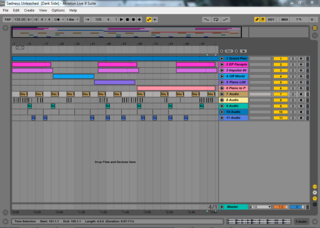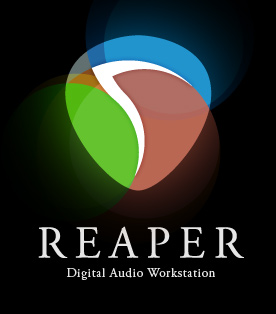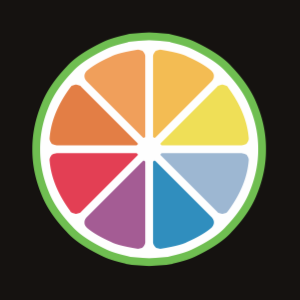
MIDI is a technical standard that describes a communication protocol, digital interface, and electrical connectors that connect a wide variety of electronic musical instruments, computers, and related audio devices for playing, editing, and recording music.

FL Studio is a digital audio workstation (DAW) developed by the Belgian company Image-Line. It features a graphical user interface with a pattern-based music sequencer. It is available in four different editions for Microsoft Windows and macOS.

Cubase is a digital audio workstation (DAW) developed by Steinberg for music and MIDI recording, arranging and editing. The first version, which was originally only a MIDI sequencer and ran on the Atari ST computer, was released in 1989. Cut-down versions of Cubase are included with almost all Yamaha audio and MIDI hardware, as well as hardware from other manufacturers. These versions can be upgraded to a more advanced version at a discount.

Virtual Studio Technology (VST) is an audio plug-in software interface that integrates software synthesizers and effects units into digital audio workstations. VST and similar technologies use digital signal processing to simulate traditional recording studio hardware in software. Thousands of plugins exist, both commercial and freeware, and many audio applications support VST under license from its creator, Steinberg.

Pro Tools is a digital audio workstation (DAW) developed and released by Avid Technology for Microsoft Windows and macOS. It is used for music creation and production, sound for picture and, more generally, sound recording, editing, and mastering processes.

GarageBand is a software application by Apple for macOS, iPadOS, and iOS devices that allows users to create music or podcasts. GarageBand was originally released for macOS in 2004 and brought to iOS in 2011. The app's music and podcast creation system enables users to create multiple tracks with pre-made MIDI keyboards, pre-made loops, an array of various instrumental effects, and voice recordings.

Ableton Live, also known as Live or sometimes colloquially as "Ableton", is a digital audio workstation for macOS and Windows developed by the German company Ableton.

Acid Pro is a professional digital audio workstation (DAW) software program currently developed by Magix Software. It was originally called Acid pH1 and published by Sonic Foundry, later by Sony Creative Software as Acid Pro, and since spring 2018 by Magix as both Acid Pro and a simplified version, Acid Music Studio. Acid Pro 11 supports 64-bit architectures, and has MIDI, ASIO, VST, VST3, DirectX Audio, and 5.1 surround sound support.

Electronic drums are a modern electronic musical instrument, primarily designed to serve as an alternative to an acoustic drum kit. Electronic drums consist of an electronic sound module which produces the synthesized or sampled percussion sounds and a set of pads, usually constructed in a shape to resemble drums and cymbals, which are equipped with electronic sensors to send an electronic signal to the sound module which outputs a sound. Like acoustic drums, the pads are struck by drum sticks and they are played in a similar manner to an acoustic drum kit, albeit with some differences in the drumming experience.

Logic Pro is a proprietary digital audio workstation (DAW) and MIDI sequencer software application for the macOS platform developed by Apple Inc. It was originally created in the early 1990s as Notator Logic, or Logic, by German software developer C-Lab which later went by Emagic. Apple acquired Emagic in 2002 and renamed Logic to Logic Pro. It was the second most popular DAW – after Ableton Live – according to a survey conducted in 2015.

LMMS is a digital audio workstation application program. It allows music to be produced by arranging samples, synthesizing sounds, entering notes via computer keyboard or mouse or by playing on a MIDI keyboard, and combining the features of trackers and sequencers. It is free and open source software, written in Qt and released under GPL-2.0-or-later.

REAPER is a digital audio workstation and MIDI sequencer application created by Cockos. The current version is available for Microsoft Windows, macOS, and Linux. REAPER acts as a host to most industry-standard plug-in formats and can import all commonly used media formats, including video. REAPER and its included plug-ins are available in 32-bit and 64-bit format.

Sonoma Wire Works is a company, based in Los Altos, California, and incorporated in 2003, that develops audio software and hardware.

JUCE is an open-source cross-platform C++ application framework, used for the development of desktop and mobile applications. JUCE is used in particular for its GUI and plug-ins libraries. It is dual licensed under the GPLv3 and a commercial license.
Reason Studios is a music software company, based in Stockholm, Sweden. Founded in 1994, it develops the studio emulation digital audio workstation and audio plug-in Reason.

Logic Studio is a discontinued professional music production suite by Apple Inc. The first version of Logic Studio was unveiled on September 12, 2007. It claims to be the largest collection of modeled instruments, sampler instruments, effect plug-ins, and audio loops ever put in a single application.
The stutter edit, or stutter effect, is the rhythmic repetition of small fragments of audio, occurring as the common 16th note repetition, but also as 64th notes and beyond, with layers of digital signal processing operations in a rhythmic fashion based on the overall length of the host tempo. The Stutter Edit audio software VST plug-in implements forms of granular synthesis, sample retrigger, and various effects to create a certain audible manipulation of the sound run through it, in which fragments of audio are repeated in rhythmic intervals. The plug-in allows musicians to manipulate audio in real time, slicing audio into small fragments and sequences the pieces into rhythmic effects, recreating techniques that formerly took hours to do in the studio. Electronic musician Brian Transeau is widely recognized for pioneering the stutter edit as a musical technique; he developed, coined the term, and holds multiple patents for the Stutter Edit software plug-in.

MAGIX Samplitude/ Sequoia is a computer program made by MAGIX for recording, editing, mixing, mastering and outputting audio. The first version was released in 1992 for the Amiga and three years later for Microsoft Windows. The latest versions of the software are Samplitude Pro X5, Samplitude Pro X8 Suite and Sequoia 17. Samplitude is an example of a digital audio workstation (DAW).
Loopmasters is a sample, MIDI file and preset distributor founded in 2003.
Maschine is a hardware/software digital audio workstation developed by Native Instruments. Maschine consists of a controller that connects to the included sequencing software, which can be installed on any compatible computer or laptop.














